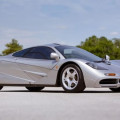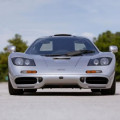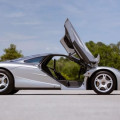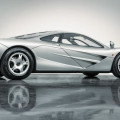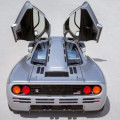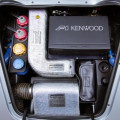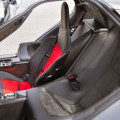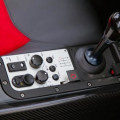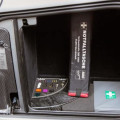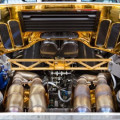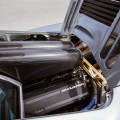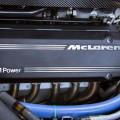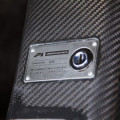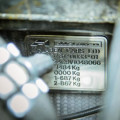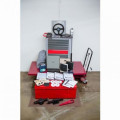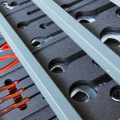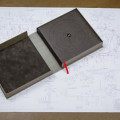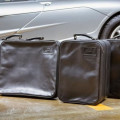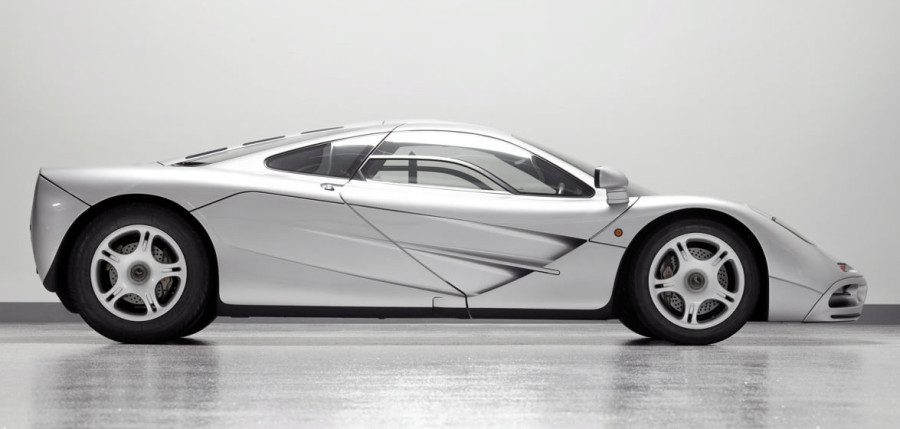
1997 McLaren F1 supercar sells at 2013 Pebble Beach auction
From August 18, 2013 — At the 2013 Pebble Beach Weekend at Monterey, California, auction house Gooding & Company sells a 1997 McLaren F1 for $8,470,000.
Car Highlights
- A Landmark in Automotive Design
- A Highly Original, Two-Owner F1
- Finished in Iconic Magnesium Silver Livery
- EPA and DOT Certified
- A Well-Documented Example with Known History
- Fastidiously Maintained by McLaren
- Includes tools, fitted luggage, service records
- Less than 14,000 Miles from New
- 2012 Full Service by the McLaren Service Center
Technical Specifications
- Chassis: #066
- VIN: SA9AB5AC9V1048066
- 6,064 CC DOHC BMW S70/2 V-12 Engine
- Sequential Closed-Loop Fuel Injection
- 627 BHP at 7,500 RPM
- 6-Speed Manual Gearbox
- 4-Wheel Drilled and Vented Brembo Brakes
- Independent Double-Wishbone Suspension Front and Rear
Gallery
Click any image below for larger view
All photographs Copyright © 2013 Gooding & Company
The McLaren F1 Story as told by Gooding & Company
If there is an automobile that represents the past, the present, and the future, it is the McLaren F1. McLaren ingeniously combined aspects of the greatest cars preceding it with the intent of making a perfect modern motorcar. The resulting F1 was brilliant, and remains the obvious benchmark for all other supercars.
The Autocar’s road test heralded:
The McLaren F1 is the finest driving machine yet built for the public road. It possesses more performance than most of the cars racing at Le Mans this year, but that is almost incidental compared to its real achievements: containing such performance within a car without guile. A car that always inspires, never intimidates.
Constructed with the same care and attention to detail that epitomizes a Formula 1 operation, Gordon Murray designed the F1 without compromise. The F1 was engineered with elegance and assembled with precision, utilizing the finest materials available including aluminum, titanium, carbon fiber, and even gold.
The engine, spearheaded by BMW Motorsport’s Paul Rosche, was tailor-made to suit the needs of the F1 development team, and the normally aspirated V-12 combines the best of all worlds. It has tremendous reserves of torque, a linear delivery, and an unforgettable sound. Not only did it make a fabulous powerplant for the road-going F1, it helped McLaren win the 24 Hours of Le Mans and served in BMW’s own successful racing efforts.
When the F1 debuted in 1992, it captured headlines in every motor magazine worldwide. In the years since, it has been bestowed with every automotive cliché, every possible hyperbole, and has been featured in countless books, films, and television series. Yet, despite its exposure in the media, it is a rare instance to see one on the road or at a show. Because of their scarcity, they make even the most exclusive supercars seem plentiful by comparison.
The F1 is not the typical overweight hyper-car, nor is it a bare-bones, kidney-jarring track toy; rather it is a lithe, beautifully engineered jewel of a car that is just as capable on a closed circuit as it is on crowded city streets. Were it not for its unique center-seat layout and drop-jawed onlookers, one might easily forget that they are piloting one of the most extreme high-performance automobiles ever produced. Professional racing drivers have remarked that it is a true enthusiast’s car – lightweight, nimble, balanced, and refined.
Owners are quick to recognize the F1’s incredible capabilities and rewarding real-world driving experience.
According to Nick Mason:
The McLaren really works. I have a particular grievance with supercar suppliers, that once they’ve spent long hours on the track they head back to base to work on the guest list and choice of canapés and Champagne for the launch party. This tends to leave a car with stunning performance and page three looks that’s actually hell to drive on the road. The McLaren isn’t like that.
Longtime F1 owner Rowan Atkinson noted:
It’s not just the quality of construction but quality of thinking that owners admire. My advice is unequivocal: if you have the money, buy one.
It has been just over 20 years since the F1 was introduced to the public and more than a decade since the last example was produced. In that time there have been many attempts to overtake the McLaren. Some may have gone faster, been more audacious, had a more dramatic combination of letters and numbers in their title, yet none has ever come close to stealing the F1’s status as the king of the modern supercar.
Time has proven that the F1 has far exceeded the expectations of both its designers and critics in countless ways.
As noted by Autocar:
We can see F1 drivers, after 20 years of ownership, still having their jaws felled by its abilities. We are also convinced that the F1 will be remembered as one of the great events in the history of the car.
Accordingly, fascination with and collectability of the F1 have grown steadily with time. The recent Octane comparison of the F1 and the legendary GTO was recently posed.
If a modern-era successor can achieve recognition as the future 250 GTO, it has to be the McLaren F1.
There is an agreeable and resounding sense that the F1 is headed along the very same, epic path. The argument, however, overlooks the fact that the F1 was a legend almost immediately; the GTO earned its praise as a collectible later in life.
The McLaren F1 has become recognized the world over as the prime example of the pursuit for automotive excellence. Perhaps the most talked-about car in history, there are few emphatic words that have not been used to describe the McLaren F1. Wordy praise alone cannot satisfy the F1’s effect on the motoring community.
McLaren F1 Chassis #066
To put it simply, chassis 066 is a quintessential example of the McLaren F1.
Chassis 066, the 54th road car, was finished in the popular livery of Magnesium Silver and sold new to German enthusiast Thomas Groth in 1997. Mr. Groth exercised 066 regularly driving his prized car to and from work on Germany’s high-speed Autobahn. A more enjoyable daily commute would be hard to fathom.
By 1998, the McLaren had accumulated approximately 7,500 km and as a responsible steward, Groth saw that the car received its requisite maintenance. He even had McLaren fashion a custom driver’s seat and steering wheel cover to preserve the interior when the car was being stored or transported. Throughout his ownership, use of the McLaren F1 diminished, yet Groth remained a vigilant owner of 066 until 2009. After 12 years of singular ownership, the F1 returned to McLaren.
Around that very time, an avid American collector, whose intrigue with the F1 dated back to its inception, was visiting the factory to take delivery of his first F1. The collector was made aware of another F1 (066) being prepared for sale by the original owner. As any sensible man would expect, by the end of the day, he became the owner of two McLaren F1s.
Before bringing 066 stateside, the current owner appointed the factory to install a quick-release steering wheel and change the odometer from kilometers to miles. At the owner’s request, a completely new leather and Alcantara interior was also installed, not because it was needed, but rather because he wanted the car to be perfect. Each of these enhancements is recorded in the car’s extensive service history. Once complete, 066 was imported to the US in December 2009, and entrusted to Wallace Environmental Testing Labs in Houston, Texas, for federalization. Upon arrival the strenuous process to meet EPA and DOT was successfully completed.
Although quite different from the German Autobahn of the car’s early outings, the Texas landscape offered great opportunities for the F1 to be enjoyed as intended. As a steward of two F1s, it should be known that the current owner is a knowledgeable caretaker, having visited the factory and attended a full course of ownership education. Under his care, the use and maintenance of 066 has been both appropriate and proactive. It has been kept in a climate-controlled environment and further benefits from a major service completed by the factory service center in Oxnard, California, in March 2012. No attention to detail has been overlooked in the maintenance and presentation of 066.
It should be duly noted that 066 is well documented, including service records from 1998 to 2013, compiled in four binders and digitally on four compact discs. The F1 additionally retains the McLaren presentation folder, the US Customs and Border Protection Summary, the US Department of Transportation Entry Letter, the US EPA Declaration Form, the US EPA Application for Final Admission, and the Wallace Environmental Testing Labs Emission Performance Summary & Warranty Certificate of Calibration.
Chassis 066, furthermore, is exceptionally complete, accompanied by the original owner’s manual in its leather-bound case; the service and warranty book; the spare key (numbered 066); the factory luggage (also numbered 066); the vanity mirror; the garment bag; gold-plated titanium tool kit and roll; Facom F1 rolling tool box complete with keys; numbered passenger wool floor mats; the 10-disc Kenwood stereo; two Guardian battery chargers; an electric torque wrench; a cotton, McLaren F1-embroidered car cover; the roadside kit with gloves; a fire extinguisher; a lightweight wheel lug wrench; a fuse and bulb kit; a spare set of headlights; the factory-designed and installed Valentine radar detector; the radar instruction book; the original Nardi-McLaren leather steering wheel; and lastly the leather-bound volume, Driving Ambitions, embossed with the car’s vehicle number.
Today, 066 remains an outstandingly original example. Unlike many F1s, 066 is not known to have been damaged or repainted in its 16 years. With the exception of the factory-renewed interior and regular servicing, the major surfaces and components are believed to be original. Showing roughly 13,900 miles, the F1 has accumulated an average of 875 miles per year since new. Used as its designers had intended, 066 offers the mileage and maintenance in which one can find comfort of the car’s prowess without undue worry of enjoyment.
As a continued focal point of the automotive community, the F1’s desirability can be confirmed by the roster of owners that includes prominent collectors, such as Ralph Lauren, Jay Leno, and Nick Mason. The number of Ferrari 250 GTO owners also in possession of a McLaren F1, as well as the numerous owners of multiple F1s, is noteworthy.
The Magnesium Silver example offered here boasts just two owners from new and a commendable maintenance record. Properly imported to the US, this F1 is bettered by its documentation, accompaniments, and originality. Chassis 066 welcomes the established and foundling collector alike with any and all expectations of what its ownership holds. The new owner of 066 will be rewarded with a turn-key example that has gone through rigorous procedures and inspections and is ready to be enjoyed as the engineers at McLaren intended. The presence of any F1 on the market is of note; this opportunity demands the attention of any collector.
